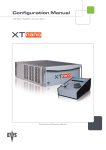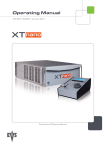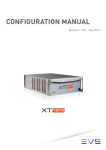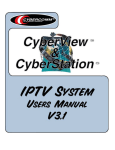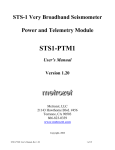Download XTnano Configuration Manual
Transcript
Configuration Manual Version 10.03 - July 2010 Production & Playout Server XTnano – Version 10.03 – Configuration Manual EVS Broadcast Equipment SA – July 2010 Issue 10.03.D C OPYRIGHT EVS Broadcast Equipment – Copyright © 2010. All rights reserved. D ISCLAIMER The information in this manual is furnished for informational use only and subject to change without notice. While every effort has been made to ensure that the information contained in this user manual is accurate, up-to-date and reliable, EVS Broadcast Equipment cannot be held responsible for inaccuracies or errors that may appear in this publication. I MPROVEMENT R EQUESTS Your comments will help us improve the quality of the user documentation. Do not hesitate to send improvement requests, or report any error or inaccuracy on this user manual by e-mail to [email protected] . R EGIONAL C ONTACTS The address and phone number of the EVS headquarters are mentioned in the Help > About menu in the user interface. You will find the full list of addresses and phone numbers of local offices on the EVS website, on the following page: http://www.evs.tv/Europe,+Middle+East+Africa/English/Contact-us/ContactUs/Regional-contacts-new-/page.aspx/2038 U SER M ANUALS ON EVS W EBSITE The latest version of the user manual, if any, and other user manuals on EVS products can be found on the EVS download center, on the following webpage: http://www.evs.tv/Europe,+Middle+East+Africa/English/Downloadcenter/page.aspx/1887 I Issue 10.03.D II XTnano – Version 10.03 – Configuration Manual EVS Broadcast Equipment SA – July 2010 XTnano – Version 10.03 – Configuration Manual EVS Broadcast Equipment SA – July 2010 Issue 10.03.D Table of Contents TABLE OF CONTENTS ................................................................................................... III 1. INTRODUCTION....................................................................................................... 1 1.1 1.2 2. PURPOSE AND STRUCTURE ....................................................................................................1 APPLICATION SELECTION AND CHANNEL CONFIGURATION ...............................................1 SETUP IN MULTICAM ............................................................................................. 2 2.1 INTRODUCTION ..........................................................................................................................2 2.1.1 Overview .................................................................................................................................2 2.1.2 How to Access the Setup Configuration ..................................................................................3 2.1.3 How to Move Inside the Setup Configuration ..........................................................................3 2.2 GENERAL SETTINGS (PAGE 1) .................................................................................................4 2.2.1 Introduction .............................................................................................................................4 2.2.2 System information .................................................................................................................4 2.2.3 OSD Settings ..........................................................................................................................5 Genlock error ............................................................................................................................................................. 5 Disk error .................................................................................................................................................................... 5 Audio meters on OSD ................................................................................................................................................ 5 Audio meters adj.(db) ................................................................................................................................................. 5 2.2.4 Clip Management ....................................................................................................................6 Default Copy/Move ..................................................................................................................................................... 6 Autoname clip ............................................................................................................................................................ 6 Date format ................................................................................................................................................................ 6 Reset archive sts........................................................................................................................................................ 7 2.2.5 Record Trains .........................................................................................................................7 2.2.6 2.2.7 2.2.8 2.2.9 Continuous loop rec ................................................................................................................................................... 7 Resync to TC ref ........................................................................................................................................................ 7 VGA Settings ..........................................................................................................................7 VGA & RMT Sync ...................................................................................................................7 Channel Names ......................................................................................................................8 General Timecode Settings .....................................................................................................8 Timecode Settings ..................................................................................................................................................... 8 Timecode Types Available on a Recorder ................................................................................................................. 9 Timecode Types Used on a Recorder ....................................................................................................................... 9 How to Setup the Primary TC and User Fields ........................................................................................................ 10 2.3 VITC/ANC TIMECODE MANAGEMENT (PAGE 2) ....................................................................11 2.3.1 VITC/ANC Management in SD IN and OUT ..........................................................................11 2.3.2 VITC/ANC Management in HD IN and HD/SD OUT .............................................................13 2.4 SMPTE 334M PACKETS MANAGEMENT (PAGE 3) ................................................................15 Activate / Deactivate VANC Data packet support .................................................................................................... 15 Packets supported ................................................................................................................................................... 15 Encoding of the SMPTE 334M packets on the downconverted outputs .................................................................. 16 Keeping Custom Uncompressed Data ..................................................................................................................... 16 Compatibility information .......................................................................................................................................... 17 2.5 GPI SETTINGS (PAGE 4) ..........................................................................................................17 2.5.1 GPI Types .............................................................................................................................17 2.5.2 GPI-Related Information .......................................................................................................18 2.5.3 How to Modify the Type of TTL GPIs ....................................................................................20 2.5.4 Using the Tally Function to Create a Director’s Cut Playlist ..................................................20 2.6 Introduction .............................................................................................................................................................. 20 How to Set up the Tally Function ............................................................................................................................. 20 HCTX GIGABIT CONNECTION SETTINGS (PAGE 6) ..............................................................21 III Issue 10.03.D XTnano – Version 10.03 – Configuration Manual EVS Broadcast Equipment SA – July 2010 2.6.1 Introduction ...........................................................................................................................21 2.6.2 Settings Description ..............................................................................................................22 2.7 LAN CONNECTION SETTINGS (PAGE 6) ................................................................................22 2.7.1 Introduction ...........................................................................................................................22 2.7.2 Settings Description ..............................................................................................................23 2.8 MULTIVIEWER SETTINGS (PAGE 10) .....................................................................................24 2.8.1 Introduction ...........................................................................................................................24 2.8.2 Settings .................................................................................................................................24 Display Settings ....................................................................................................................................................... 25 Audio Monitoring Settings ........................................................................................................................................ 26 Aspect Ratio Settings ............................................................................................................................................... 26 DB15 Output Setting ................................................................................................................................................ 26 2.9 SAVING AND LOADING SETUP FILES ....................................................................................27 2.9.1 How to Save Current Setup ..................................................................................................27 2.9.2 How to Load a Setup File ......................................................................................................27 2.9.3 How to Delete a Setup File ...................................................................................................27 Importing/Exporting a Setup File .............................................................................................................................. 27 3. SETUP FROM THE REMOTE PANEL ................................................................... 28 3.1 INTRODUCTION ........................................................................................................................28 3.2 GENERAL LAYOUT ...................................................................................................................28 3.3 HOW TO ACCESS THE SETUP MENU ....................................................................................30 3.4 HOW TO NAVIGATE IN THE SETUP MENU ............................................................................30 3.5 HOW TO SELECT AND TO MODIFY PARAMETERS...............................................................31 3.6 HOW TO RESET THE DEFAULT VALUES ...............................................................................31 3.7 OSD SETTINGS ........................................................................................................................32 3.7.1 Genlock Error Msg ................................................................................................................32 3.7.2 Disk Error Msg ......................................................................................................................32 3.7.3 Cue Number on OSD ............................................................................................................32 3.8 RECORD TRAIN SETTINGS .....................................................................................................33 3.8.1 Auto make clip for cam A/B/C ...............................................................................................33 3.8.2 Resync to TC ref ...................................................................................................................33 3.8.3 Guardbands ..........................................................................................................................34 3.8.4 Default clip duration ..............................................................................................................34 3.8.5 Mark cue points .....................................................................................................................34 3.8.6 Preroll....................................................................................................................................34 3.8.7 Record train OUTs ................................................................................................................35 3.8.8 Freeze on cue points.............................................................................................................35 3.8.9 Internal loop mode ................................................................................................................35 3.9 CLIPS SETTINGS ......................................................................................................................36 3.9.1 Protect pages ........................................................................................................................36 How to Protect Clips on Selected Pages ................................................................................................................. 37 3.9.2 Confirm Delete ......................................................................................................................37 3.9.3 Auto name clips ....................................................................................................................38 3.9.4 Clip post-roll ..........................................................................................................................38 3.9.5 Target....................................................................................................................................39 3.9.6 Target 1 & 2 ..........................................................................................................................39 3.9.7 Mode .....................................................................................................................................39 3.9.8 Receive Page ........................................................................................................................40 3.9.9 PLST receive Pg ...................................................................................................................40 3.9.10 Reset Archive Status.............................................................................................................40 3.10 PLAYLIST SETTINGS................................................................................................................41 3.10.1 Video effect duration .............................................................................................................41 IV XTnano – Version 10.03 – Configuration Manual EVS Broadcast Equipment SA – July 2010 Issue 10.03.D 3.10.2 Wipe type ..............................................................................................................................41 3.10.3 Default plst speed .................................................................................................................41 3.10.4 Insert in playlist .....................................................................................................................41 3.10.5 Confirm Ins/del clips ..............................................................................................................42 3.10.6 Playlist loop ...........................................................................................................................42 3.10.7 Load playlist ..........................................................................................................................42 3.10.8 Playlist auto fill ......................................................................................................................42 3.10.9 Fade to/from color .................................................................................................................43 3.11 AUDIO SETTINGS .....................................................................................................................43 3.11.1 Audio slow motion .................................................................................................................43 3.11.2 Lipsync value (ms) ................................................................................................................43 3.11.3 Audio meters on OSD ...........................................................................................................44 3.11.4 Audio meters adj.(db) ............................................................................................................44 3.11.5 Aux track output ....................................................................................................................44 3.12 EVS CONTROLLER SETTINGS ................................................................................................45 3.12.1 Effect duration for Take .........................................................................................................45 3.12.2 Fast jog .................................................................................................................................45 3.12.3 Pgm Speed/Var Max .............................................................................................................45 3.12.4 Lever engage mode ..............................................................................................................45 3.12.5 Second lever range ...............................................................................................................46 3.12.6 Recall Clip Toggle .................................................................................................................46 3.12.7 Record key ............................................................................................................................47 3.12.8 VGA & RMT Sync .................................................................................................................47 3.12.9 PGM/PRV Mode ...................................................................................................................48 3.13 CONTROLLER AND PROTOCOL SETTINGS ..........................................................................48 3.13.1 RS422 #1 .............................................................................................................................48 3.13.2 RS422 #2 .............................................................................................................................48 3.14 GPI IN SETTINGS .....................................................................................................................49 3.14.1 TTL GPIs Assignment ...........................................................................................................49 3.14.2 GPIs IN Definition..................................................................................................................49 Channel/Device ........................................................................................................................................................ 50 Function ................................................................................................................................................................... 50 3.14.3 GPIs IN Delay .......................................................................................................................50 3.14.4 GPIs OUT Definition..............................................................................................................51 3.14.5 GPIs OUT Advance and Duration .........................................................................................52 GPI OUT Advance ................................................................................................................................................... 52 GPI Pulse Duration .................................................................................................................................................. 52 GLOSSARY ..................................................................................................................... 53 REGIONAL CONTACTS ................................................................................................. 54 V XTnano – Version 10.03 – Configuration Manual Issue 10.03.D EVS Broadcast Equipment SA – July 2010 1. Introduction 1.1 PURPOSE AND STRUCTURE The aim of this manual is to describe the various configuration parameters that have to be defined when you work on a server in Sportlight mode. 1.2 APPLICATION SELECTION AND CHANNEL CONFIGURATION Prior to configuring the Multicam and server settings in the Setup Configuration module or on the nano Remote Panel, you must have selected the application you will run on the server. In this step, you also define the channel configuration to be used with the selected application, as well as several audio and video parameters for the server. You perform this initial step in the EVS and AVCFG software programs. The EVS software is started when the server is switched on. For more information on this, refer to the XTnano Tech Ref Software manual. If a default application has been previously selected, this application will start automatically after a few seconds if no key is hit. If a default application hasn't been defined or if the space bar is hit, the system will remain in the EVS main menu and wait for the operator's next command. 1 Issue 10.03.D XTnano – Version 10.03 – Configuration Manual EVS Broadcast Equipment SA – July 2010 2. Setup in Multicam 2.1 INTRODUCTION 2.1.1 OVERVIEW When you work in Spotbox mode, the ‘Setup Configuration’ module available in the Multicam application, using the SHIFT + F2 keyboard combination, allows you to configure the Multicam software and define server settings in relation to timecodes, protocol communication, etc. The other Multicam modules are discussed in the following manuals: • Monitoring modules in the XTnano Tech Ref Software manual • Multicam application in the User manual This module contains several pages, or screens, which are described in details in this section: Setup page and section name Content Page 1 It includes several general settings on the timecodes, the OSD, the VGA, the clip management, the record trains, the channel names. See Section 2.2 ‘General Settings (Page 1)’, on page 4. Page 2 See Section 2.3 ‘VITC/ANC Timecode Management (Page 2)’, on page 11 Page 3 See section 2.4 ‘SMPTE 334M Packets Management (Page 3)’, on page 15. Page 4 See section 2.5 ‘GPI Settings (Page 4), on page 17 2 It includes detailed settings on the insertion of VITC or ANC timecodes, channel by channel. It includes settings on the SMPTE 334M packet management. It includes the settings on the GPIs IN and OUT XTnano – Version 10.03 – Configuration Manual Issue 10.03.D EVS Broadcast Equipment SA – July 2010 Setup page and section name Content Page 5 Not available for XTnano. Page 6 It includes detailed settings on the HCTX gigabit connection and the MTPC board connection. See section 2.6 ‘HCTX Gigabit Connection Settings (Page 6)’, on page 21 and 2.7 ‘LAN Connection Settings (Page 6)’, on page 22 Page 7/8/9 Not available for XTnano. Page 10 It includes the settings for the connection of an external multiviewer. See section 2.8 ‘Multiviewer Settings (Page 10)’, on page 24 2.1.2 HOW TO ACCESS THE SETUP CONFIGURATION The Setup Configuration module is available by pressing simultaneously SHIFT + F2 on the keyboard with CAPS LOCK disabled. The Setup Configuration is not accessible if CAPS LOCK is ON. 2.1.3 HOW TO MOVE INSIDE THE SETUP CONFIGURATION • Use TAB or SHIFT + TAB to move from one parameter to the next or previous one, and the LEFT or RIGHT ARROW keys to change the value of a parameter. • Use PAGE UP and PAGE DOWN to access the other configuration screens. 3 Issue 10.03.D XTnano – Version 10.03 – Configuration Manual EVS Broadcast Equipment SA – July 2010 2.2 GENERAL SETTINGS (PAGE 1) 2.2.1 INTRODUCTION The first page of the Setup Configuration module contains some parameters from the Setup menu of the nano Remote Panel that are useful to adjust when working in a Spotbox mode. If you modify the values for parameters available both in the Setup menu of the Remote Panel and in the Setup Configuration menu, the changes are reflected immediately in the Remote Setup Menu, and vice-versa. 2.2.2 SYSTEM INFORMATION The Setup screen also provides information about: • The actual and maximum number of clips on the server: 5400 clips. • The version of the Multicam software. • The codec and video configuration, a nd bitrate used. • The computer current date and time. • The synchronization of the computer time with the timecode. 4 XTnano – Version 10.03 – Configuration Manual EVS Broadcast Equipment SA – July 2010 2.2.3 Issue 10.03.D OSD SETTINGS You can also define the OSD settings on page 1.1 or 5.1 of the setup menu on the Remote Panel. You will find a description of these settings in the Multicam user manual. G ENLOCK ERROR Possible v alues: Yes (default) / No This function enables or disables the Genlock information on the output monitor. If Genlock refere nce is not correct, the “ !GkV” message appears on the output monitor. D ISK ERROR Possible values: Yes (default) / No This function displays an error message “ !Raid” on the output monitor when a disk is fa u lty . Note The server is equipped with a RAID disk array. This means that the operation can continue seamlessly even with one faulty disk. If one disk is disconnected during operation, the “ !Raid” message appears on all output monitors, and another message appears when the operator shuts down the application, to invit e him to replace the disk and rebuild the RAID array. Refer to the XTnano Tec h Ref Hardware manual for details on the RAID system and its maintenan ce. A UDIO METERS ON OSD Possible values: Yes (default) / No This parameter enables/disables t he display of audio meters at the bottom of each output monitor. A UDIO METERS ADJ .( DB ) Possible range: -83.2 dB to 0 dB. Default 0 dB This parameter allows adjus ting the sensitivity of audio meters on the OSD of the output monitors. A positive v alue means that the meters will be more sensitive. 5 Issue 10.03.D 2.2.4 XTnano – Version 10.03 – Configuration Manual EVS Broadcast Equipment SA – July 2010 CLIP MANAGEMENT You can also define m ost of the Clip management settings on pages 3.1 to 3.3 of the setup menu on the Remote Panel. You will find a description of these settings in the Multicam user manual. D EFAULT C OPY /M OVE Possible value: GbE The Default Copy/Move parameter allows specifying whether the copy operations should be executed preferably using the SDTI or the HCTX GigE network. Since only the GigE network is available on XTnano servers, the value for this parameter is forced to GbE. A UTONAME CLIP Possible values: Disable (default) / TC IN / Cam Name / ID Louth / VarID 32 If this function is enabled, the value of the selected field will automatically be used to nam e the clip upon creation. The values from the following fields can be used to automatically name clips: Value Meaning Disable No name is assigned to a clip when it is created. Default value. TC IN The timecode of the IN point of the cl ip is automatically assigned to a clip when it is created. Cam Name The name of the recorder channel is automatically assigned to a clip when it is created. ID Louth The ID Louth of the clip, that is a unique identifier for the clip, is assigne d to a clip when it is created (used mostly with an XNet network not available with XTnano). VarID 32 The VarID 32 of the clip is assigned to a clip when it is created. When this option is selected, the VarID 32 used to assign a name to the clip will be limited to the first 8 characters of this field. D ATE FORMAT Read-only value: dd/mm/yy This is the date format used for the dates in searches or in clip information display. This parameter is read-only and provided for information purpose. 6 XTnano – Version 10.03 – Configuration Manual Issue 10.03.D EVS Broadcast Equipment SA – July 2010 R ESET ARCHIVE STS Pressing F6 will reset the archive status of all clips present on the system. A confirmation is required. Refer to the description of the Archive function for details. 2.2.5 RECORD TRAINS C ONTINUOUS LOOP R EC This setting is read-only in the setup configuration window. It corresponds to the value assigned to the Loop Rec setting for the related configuration in the AVCFG. R ESYNC TO TC R EF You can also define this setting on page 2.1 of the setup menu on the Remote Panel. You wil l find a description of this setting in the Multicam user manual. 2.2.6 VGA SETTINGS You can also define the VGA & RMT Sync setting on page 6.2 of the setup menu on the Remote Panel. You will find a description of these settings in the Multicam user manual. 2.2.7 VGA & RMT SYNC Possible values: No, Ye s, Svr This parameter selects whether and how the current clips machine, page and bank of VG A screens and EV S Remote Panel must be synchronized. Value Meaning No (Default) Clip machine, page and bank can be sele cted independently on the VGA screen and on the EVS Remote P anel. Yes Clip machine, page and bank are synchronized between VGA screen and EVS Remote Panel. Connecting to the clips of a network machine or coming back to the clips of the local machine, or selecting a new page or bank on one side will be automatically reflected on the other. 7 Issue 10.03.D 2.2.8 XTnano – Version 10.03 – Configuration Manual EVS Broadcast Equipment SA – July 2010 Value Meaning Svr Clip pages and banks can be selected independently on VGA and remote, but connecting to the clips of a network machine or coming back to the clips of the local machine on the VGA or Remote Panel will automatically reflect on the other (same effect as ‘No’ on XTnano). CHANNEL NAMES Play and record channels can be named (12 characters max.). The name of record channels will be displayed on the OSD of t he video output monitor when a record train is loaded, displayed on the E/E monitoring outputs and can also be used to name clips automatically when the Autoname clip parameter is set to “ CAM name” . The name of the player channel will be displayed on the OSD, but truncated to 4 characters. 2.2.9 GENERAL TIMECODE SETTINGS From Multicam version 9 onwards, the management of timecodes has been improved. The users can now choose which type of timecode they want to use as the reference to work on a given recorder of a server. This is made possible by the management of two timecode jump tables. T IMECODE S ETTINGS The timecode jump tables contain rec ords with timecodes of video material recorded on the server. A new record is created in the table each time a jump in timecodes is detected on the recorded material. The records of timecode jumps allow the identification of all the recorded material. The timecode jump tables are u sed on all searches for and manipulations of video material recorded on a server. The tw o timecode jump tables are filled with the following data: • The first table is always filled in with the LTC timecode. This is the timecode defined on or plugged into the server. • Th e s econd table is filled in with the timecodes selected by the user. This can be one of the following timecode type: 8 o LTC and VITC (default) timecodes in SD o LTC, HANC LTC (default) or HANC VITC in HD XTnano – Version 10.03 – Configuration Manual EVS Broadcast Equipment SA – July 2010 Issue 10.03.D Note The timecode jump tables are circular: when the table is full, the latest entry will overwrite the oldest one. For more information on the settings related to the timecode jump tables, refer to the sections below. For more information on the settings related to the definition and monitoring of timecode jumps, refer to section on the timecode statuses in the Server Monitoring section of the XTnano Tech Ref Software manual. T IMECODE T YPES A VAILABLE ON A R ECORDER The settings related to the timecode jump tables are specified on the first page of the Setup screen (accessed via SHIFT + F2). The operators can use two types of tim ecodes to work with the video material stored by a given recorder on a server: • The LTC timecodes are automatically stored in the first timecode jump table called the ‘LTC table’. This is specified in the LTC field, which is not editable. • The second type of timecodes has to be specified by the user in the USER field. It will be stored in the second timecode jump table, the ‘USER TC table’. The users can specify one of the f ollowing timecode types in the USER setting: • LTC and VITC timecodes in SD • LTC, HANC LTC and HANC VITC in HD The user will have the possibility to work with one of the timecode types defined for the recorder. Usually, an LTC timecode is used to perform operations on live events. A VITC timecode is used for video material ingested from tapes as it is the timecode embedded in the video signal. T IMECODE T YPES U SED ON A R ECORDER On the first page of the VGA Setup screen, the Prim.TC field (Primary TC) specifies which timecode type will be displayed at the bottom the VGA and will be used to work with the video material stored on the given recorder. 9 Issue 10.03.D XTnano – Version 10.03 – Configuration Manual EVS Broadcast Equipment SA – July 2010 Possible Values The values can be the following: • LTC LTC timecode, which is automatically stored in the LTC table. It is specified in the LTC field • USER User-defined timecode, which is stored in the USER TC table and specified in the USER field. Timecode Color on the OSD Depending on the value selected for this setting, the timecode displayed at the bottom of the user’s OSD will have a different color: • If the LTC timecode is selected, the timecode color will be white. • If the USER timecode is selected, the timecode color will be yellow. H OW TO S ETUP THE P RIMARY TC AND U SER F IELDS To set up the primary TC or VITC field, proceed as follows: 1. Press SHIFT + F2 to open the Setup screen. 2. Use the TAB key to position the cursor on the field to edit. 3. Us e the LEFT and RIGHT ARROW keys to go through the possible values for that f ield. The valu e defined when you leave the field will be saved. 10 XTnano – Version 10.03 – Configuration Manual EVS Broadcast Equipment SA – July 2010 2.3 Issue 10.03.D VITC/ANC TIMECODE MANAGEMENT (PAGE 2) The second page available in the Setup Configuration menu ( SHIFT + F2) on servers allows the channel-by-channel management of VITC or ANC TC management. It also allows the users to clean or not the VBI information: the VITC being recorded in the active video lines, it can be disrupted in play var because of interpolation or parity violation on some fields. Moreover, if the server inserts VITC on the output while there is already VITC on another line, it can create problems. The server allows the user to totally clean the VBI information from the vertical blanking at playback or to clean it only when it would not have been preserved. 2.3.1 VITC/ANC MANAGEMENT IN SD IN AND OUT In SD, the page is as follows: 11 Issue 10.03.D XTnano – Version 10.03 – Configuration Manual EVS Broadcast Equipment SA – July 2010 The following parameters can be defined: IN LOOP D-VITC The TC and user bits are always written on the SD outputs of the record codec and are the same as on the source video. Lines Lines on which the VITC must be written on the output connectors of the record codec. By default, these are lines 14-16 in NTSC and 19-21 in PAL. SD OUT D-VITC Field to specify if embedded timecode has to be inserted in the output. The possible values are: No No new timecode inserted in the output. In (default) Same timecode as in the input inserted in the output. LTC Timecode from the LTC table inserted in the output. USER User-defined output. timecode inserted in the Lines Lines on which the specified timecode must be written on the output. UserBits Yes/No flag to specify if the user bits have to be included in the output. The default value is ‘Yes’. Clean VBI Field in which the use specifies whether the VBI needs to be cleaned on the output. The possible values are: 12 No The VBI is not cleaned in the output. Always The VBI is always cleaned in the output. If not OK The VBI is cleaned in the output if it is not correct (play var mode, vertical split screen, etc.) XTnano – Version 10.03 – Configuration Manual Issue 10.03.D EVS Broadcast Equipment SA – July 2010 2.3.2 VITC/ANC MANAGEMENT IN HD IN AND HD/SD OUT In HD, th e pag e is as follows: The following p aramete rs can be defined: IN LOOP D-VITC The TC and user bits are always written on the monitoring SD outputs of the record codec and are the same as on the source video. Lines Lines on which the VITC must be written on the monitoring output connectors of the record codec. By default, these are lines 14-16 in NTSC and 19-21 in PAL . HD OUT HANC LTC Field to speci fy if embedded timecode has to be inserted in the output. The value specified has to be the same as for the HANC V ITC field . The possible values are: No No new timecode inserted in the output. In (default) Sam e timecode as in the input inserted in the output. LTC Timecode from the LTC table inserted in the output. USER User-defined output. timecode inserted in the 13 Issue 10.03.D XTnano – Version 10.03 – Configuration Manual EVS Broadcast Equipment SA – July 2010 UserBits Yes/No flag to specify if the user bits have to be inserted in the output. The default value is ‘Yes’. HANC VITC Field to specify if embedded timecode has to be inserted in the output. The valu e specified has to be the same as for the HANC LTC field. The possible values are: No No new timecode inserted in the output. In (default) Same timecode as in the input inserted in the output. LTC Timecode from the LTC table inserted in the output. USER User-defined output. timecode inserted in the SD OUT D-VITC Lines Field to specify if embedded timecode has to be inserted in the output. The possible values are: No No new timecode inserted in the output. In (default) Same timecode as in the input inserted in the output. LTC Timecode from the LTC table inserted in the output. USER User-defined output. timecode inserted in the Lines on which the specified timecode must be written on the loop of the input. By default, these are lines 14-16 in NTSC and 19-21 in PAL. 14 UserBits Yes/No flag to specify if the user bits have to be inserted in the o utput. The de fa ult value is ‘Yes’. Clean VBI Field in which the use specifies whether the VBI needs to be c leane d on the output. The possible values are: No The VBI is not cleaned in the output. Always The VB I is always cleaned in the output. If not OK The VBI is cleaned in the output if it is not correct (play v ar mode, vertical split screen, etc.) XTnano – Version 10.03 – Configuration Manual EVS Broadcast Equipment SA – July 2010 2.4 Issue 10.03.D SMPTE 334M PACKETS MANAGEMENT (PAGE 3 ) In Multicam, ancillary data packet in the vertical ancillary data space in HD and SD signals are suppo rted, as de fined in the SMPTE standards 334M, 291M (t ype 2 ANC packet). A CTIVATE / D EACTIVATE VANC D ATA PACKET SUPPORT In the Set up Configuration module ( SHIFT + F2), press PAGE DOWN until you access the SMPTE 334M Packet Management section. You can tur n o n/off the SMPTE 334M packet decoding for each record channel. You can turn on/off the SMPTE 334M packet encoding for each player channel. P ACKETS SUPPORTED Up to now, SMPTE 334M data packets carried on the chrominance (C) data stream within the SMPTE 292M signal a re not decoded (HD). In Multicam, all DIDs mentioned in the SMPTE 334M standards are supported: • 61 Î 62 • 40 Î 5F • C0 Î DF Those DIDs are saved and restored on the output channels on their original lines. 15 Issue 10.03.D XTnano – Version 10.03 – Configuration Manual EVS Broadcast Equipment SA – July 2010 The other DIDs are not saved. The maximum number of bytes saved per field (frame for 720p) is 2014. One saved SMPTE 334M packet is composed of user data word (UDW) plu s 7 configuration bytes. It has to be taken into account to compute the numbe r of bytes saved. Please refer to the SMPTE RP 291-2006 standard for the assignment of DIDs to specific applications. E NCODING OF THE SMPTE 334M PACKETS ON THE DOWNCONVERTED OUTPUTS Multicam 8.03, and higher versions, can manage the encoding of the SMPTE334M present on the HD output on the SD downconverted output as well. This parameter can be activated on the shift-F2 screen. For the downconverted output, one SMPTE 334M packet is encoded per line starting from the second line after the line specified for the switching line. In other words, the maximum number of packet per field is as follows: • 8 packets per field in 525i (lines 12-19 and 275-282) • 15 packets per field in 625i (lines 8-22 and 321-335) The limitations are: The data are re-encoded in the same order as they were in HD, b ut not necessarily on the same lines. If VITC in inserted in the downconverted output, no SMPTE 334M data will be inserted on the lines carrying the VITC. K EEPING C USTOM U NCOMPRESSED D ATA Upon request, it is possible to customize the decoding of the SMPTE 334M data. If you wish to keep uncompre ssed 8-bit data in the VANC data space, you can select two lines - L a and L b - on which N a and N b bytes can be saved per field (frame for 720p). The saved data are left aligned after SAV (Start of Active Video) and the maximum number of data saved (N a + N b + regular SMPTE 334M packet) must not exceed 2014 . If you require this customization, please contact your EVS representative to specify the n umber of bytes you want to keep and on which lines. EVS will provide you with a sp ecific customization file. This specific configuration file will be activated using the Custom VANC grab 1 and 2 parameters in the SHIFT + F2 screen. 16 XTnano – Version 10.03 – Configuration Manual EVS Broadcast Equipment SA – July 2010 Issue 10.03.D C OMPATIBILITY INFORMATION SDI Video streams (SD or HD) recorded with SMPTE 334M must be played by a server running a version equal or higher to Multicam 8.03 to keep the 334M information. 2.5 GPI SETTINGS (PAGE 4) On the fourth page of the Setup Configuration module ( SHIFT + F2), it is possible to define GPI settings: 2.5.1 GPI TYPES Three types of GPIs are available to be used on the servers: • Relay GPIs, which are always GPIs OUT, numbered from 1 to 4. • OPTO GPIs, which are always GPIs IN, numbered from 1 to 4. • TTL GPIs, which are switchable from G PIs IN to GPIs OUT or vice versa. By default, they are GPIs IN. If TTL GPIs are already assigned when you switch their type, a warning message will be displayed. 17 Issue 10.03.D 2.5.2 XTnano – Version 10.03 – Configuration Manual EVS Broadcast Equipment SA – July 2010 GPI-RELATED INFORMATION The following informatio n is defined for each individual GPI IN: Setting Description # GPI number Channel/Device Server channel or external device that will send the GPI. Port Port on which the server will receive the GPI. Function Operation executed by the server when receiving the given GPI IN. The following functions can be defined depending on the protocols: Play Initiates a play command at 100% on the selected channel. Pause Initiates a pause command on the selected channel. Recue Initiates a jump to the IN point of the on air element on the selected channel. If this is a playlist, the ju mp is performed to the IN point of the first clip of the playlist. 18 Previous Initiates a command to go to the previous clip of a playlist on the selec ted channel. Next Initiates a command to go to the next cli p of a playlist on the selected channel. Skip Initiates a command to skip the clip being played on the selected channel. Tally Activates or deactivates the on-air flag on the selected channel. This GPI is only used by IPDirector. Mark IN Sets an IN point on the corresponding recorder channel. Mark OUT Sets an OUT point on the corresponding recorder channel. Mark Tly Sets IN and OUT points on record trains based on changes in camera angles of the director’s cut. An IN point is set on the train to which the director switches and an OUT point is set on the train that the director leaves. XTnano – Version 10.03 – Configuration Manual Issue 10.03.D EVS Broadcast Equipment SA – July 2010 Setting GPI Delay Description Exit ASP Init iates a command to exit the loop as soon as possible without playing the current element until its end an d jump to the selected element. This GPI is used with playlists in IPDirector. Exit OUT Initiates a command to exit the loop as soon as the OUT point of the current element is reached and jump to the selected eleme nt. This GPI is used with playlists in IPDirect or. None No value is defined. Number of seconds and/or frames that the server will wait after receiving the GPI IN signal to execute the GPI-related function. The d efault value is ‘disabled’. The following information is defined for each individual GPI OUT: Setting Description # GPI number Function Operation that will trigger the GPI OUT. The GPI OUT can be defined with the f ollowing function: • Replace function Type Type of GPI signal. Four types are possible: Close-High The trigger is done when the level changes to high level Close-High Pulse The trigger is done on a rising edge pulse Open-Low The trigger is done when the level changes to low level Open-Low Pulse The trigger is done on a falling edge pulse. GPI OUT advance Number of seconds and/or frames ahead of the timecode (on w hich a GPI is defined) corresponding to the time when the GPI OUT will be sent by the server. The default value is ‘disabled’. GPI Pulse Duration The pulse duration needs to be defined for pulse signals. The default value is ‘disabled’. 19 Issue 10.03.D 2.5.3 XTnano – Version 10.03 – Configuration Manual EVS Broadcast Equipment SA – July 2010 HOW TO MODIFY THE TYPE OF TTL GPIS To modify the type o f TTL GPIs , pro ceed as follows: 1. Press the TAB key to select th e field on the first line of Page 4. 2. Press the LEFT and RIGHT AR ROW keys to change th e value. Depending on the ty pe defined, the lines 5 to 8 will automatically move from one GPI section to the other. For more information on the GPI IN settings, refer to section on the GPI IN settings in the Setup menu chapter of the Multicam user manual. 2.5.4 USING THE TALLY FUNCTION TO CREATE A DIRECTOR’S CUT PLAYLIST I NTRODUCTION The Tally feature allows the users to automatically create a clip for each change of camera perform ed on the dir ector’s cut and to add all the clips to a playlist. The clips are created automatically by the server as it receives GPIs IN from a switcher w hen the director changes the camera angle. H OW TO S ET UP THE T ALLY F UNCTION You will set up the Tally function on page 4 of the Setup Configuration. To set up the tally function, proceed as foll o ws : 1. Press the TAB key to sele ct the Tally f ield value and press the LEFT and RIGHT ARROW keys t o set the Tall y func tion to ‘ON’. 2. In the Add cli ps to PL fiel d, specify th e LSM ID of the playlist to which you want to add the tally clips. 3. In the Clips g uardbands field, speci fy h ow much the guardbands should be in seconds. 4. In th e GPIs I N section, for a given GPI, • s elect the REC on which the director’s cut is performed • define the ‘Mark Tly’ function on this GPI IN The tally fu nction is now active: When the server receives a ‘Mark tally’ GPI, an IN point is marked on the corresponding record train (for ex. cam a). When a second ‘Mark Tally’ GPI is received on a different record train (for ex. cam b), the server marks an OUT point on the first record train (cam a) and an IN point on the second record train. All the clips created this way are added to the defined playlist. 20 XTnano – Version 10.03 – Configuration Manual EVS Broadcast Equipment SA – July 2010 Issue 10.03.D 2.6 HCTX GIGABIT CONNECTIO N SETTINGS (PAGE 6) 2.6.1 INTRODUCTION In the Setup Configuration module (SHIFT + F2), press the PAGE DOWN key until you access the page 6. It displays the connection parameters for the HCTX board and the MTPC board. The XTnano servers support a Gigabit Ethernet connection. It allows the backup of the audio an d video data. The Gigabit connection is provided via the HCTX board. Its backplane is equipped w ith two Gigabit Ethernet ports. The settings need to be defined on at least one port for the server to be able to operate the Ethernet connection. 21 Issue 10.03.D 2.6.2 XTnano – Version 10.03 – Configuration Manual EVS Broadcast Equipment SA – July 2010 SETTINGS DESCRIPTION The HCTX Gigabit connection settings are described in the table below: Port #1 / Port #2 IP Address Specifies the IP address to connect to port 1 / port 2 of the G igabit Ethernet connection on the server. The IP addresses 0 .0.0.0 and 255.255.255.255 are not allowed. Subnet Mask Specifies the range of logical addresses within the address space assigned to the Gigabit Ethernet network. In the screenshot, the logical addresses available within the network are from 128.1.254.1 to 128.1.254.254. Default Gateway Specifies the IP address of the router on the Gigabit Ethernet network that serves as an access point to external networks. FTP Login User name Specifies the user name for an FTP access to the server via the Gigabit Ethernet connection. Password Specifies the password for an FTP access to the server via the Gigabit Ethernet connection. The password is not hidden. Note The modifications of parameter values in this screen are not applied when you leave the field. You need to select the APPLY option at the bottom right of the screen and press ENTER to apply the modifications. 2.7 LAN CONNECTION SETTINGS (PAGE 6) 2.7.1 INTRODUCTION The settings for the connection with the MTPC board are defined in the Setup Configuration module, on page 6. This will allow interaction between the LAN and the MTPC board for the purpose of system maintenance. The MTPC board and another workstation on the XNet network will communicate through telnet or FTP access. 22 XTnano – Version 10.03 – Configuration Manual EVS Broadcast Equipment SA – July 2010 Issue 10.03.D The XNetMonitor will use the LAN IP connection to transfer the monitoring data. 2.7.2 SETTINGS DESCRIPTION The MTPC b oard con n ection settings are described in the table below: Port #1 IP Address Specifies the IP address to connect to the port 1 of the MTPC board on the server. The IP addresses 0.0.0.0 and 255.255.255.255 are not allowed. Subnet Mask Specifies the range of logical addresses within the address space assigned to the MTPC board connection. Default Gateway Specifies the IP address of the router on the XNet network that the MTPC board can use as an access point to external networks. Note The modifications of parameter values in this screen are not appli ed when you leave the field. You need to select the APPLY option at t he bottom right of the screen and press ENTER to apply the modifications. 23 Issue 10.03.D 2.8 XTnano – Version 10.03 – Configuration Manual EVS Broadcast Equipment SA – July 2010 MULTIVIEWER SETTINGS (PAGE 10) The Page 10 of the Setup Configuration module makes it possible to specify the settings for a multiviewer connected to the server. 2.8.1 INTRODUCTION When an optional m ultiviewer board is installed on the server, you can monitor the server channe ls on a multiviewer. The server is connec ted to the display device via one of the dedicated connectors on the server backpl ane: • HD SDI connector • SD SDI connector • DB15 configurable connector. When th e multiviewer board is installed, Multicam automatically detects it. Thi s means the multiviewer feature is directly available and the user can specify the multiviewer settings. Otherwise, the message !Not Detected! is displayed on the first line of Page 10. 2.8.2 SETTINGS As usual in the SHIFT + F2 screens, you move from one field to the over with the <TAB> key and you change the value of a field by means of the arrow keys. 24 XTnano – Version 10.03 – Configuration Manual EVS Broadcast Equipment SA – July 2010 Issue 10.03.D D ISPLAY S ETTINGS Multiviewer Composition The number of recorder or player channels to be displayed and the multiviewer composition are defined in the field below: The selected composition is shown on the schema on the right. The following compositions are possible: Value Composition 4 (2+2) 2 split images at the top and 2 at the bottom. This is the default composition for XT[2] 4U. 6 (4+2) 4 small split images at the top and 2 large split images at the bottom of the screen. This is impossible to display the same source in small and large size. If the user has already set a small image at the top and tries to set the same in a large size, the small one is automatically replaced by ‘None’. This is composition is not useful with an XTnano. 6 (3+3) 3 split images at the top and 3 at the bottom. This is composition is not useful with an XTnano. 25 Issue 10.03.D XTnano – Version 10.03 – Configuration Manual EVS Broadcast Equipment SA – July 2010 Displayed Channels For each source, you need to specify which recorder channel (CAM A to CAM C max.) or player channel (PGM1 to PGM2 max.) available in the current channel configuration should be displayed. If you select ‘None’, no image is displayed. A UDIO M ONITORING S ETTINGS In the Audio Monitoring from video field, you can select the channel for which the audio can be monitored via the SDI outputs. In the left-right track field, you can select the pair of stereo audio tracks of the selected channel which should be monitored. By default, the first stereo pair of the source displayed in the top left image is selected. A SPE CT R ATIO S ETTI NGS In the V ideo s field of the Aspect Ratio group box, you c an change the aspect ratio of the video in HD. The following aspect ratios are available: • 16:9 Anamorphic (default) • Crop • 4:3 aspect In the SD downconverted field of the Aspect Ratio group box, you can change the aspect ratio of the video in SD. The following aspect ratios are available: • 16:9 Anamorphic (default) • 4:3 Crop • 4:3 Letterbox DB15 O U TPUT S ETTING It is possible to configure the DB15 output and use one of the following format: • RGB HD (default) • CVBS • YUV HD 26 If you use the CVBS format, the connected multiviewer needs to be in full HD and to support the country-specific frequency. XTnano – Version 10.03 – Configuration Manual Issue 10.03.D EVS Broadcast Equipment SA – July 2010 2.9 SAVING AND LOADING SETUP FILES Twenty setup files can be saved on the XT system disk. 2.9.1 HOW TO SAVE CURRENT SETUP To save the current setup, proceed as follows: 2.9.2 1. Press F4. 2. Enter a file name. The file name contains max. 8 characters, no space or special character. 3. Press E NTER. HOW TO LOAD A SETUP FILE 1. Press F5. 2. Select the desired file with the ↑ /↓ arrow keys. 3. Press ENTER. A user message pops-up for the user to confirm which settings to load back. 4. Answer to the message by selecting the letter corresponding to the requested settings to load back : • (O) Operational settings (pages 1 to 6 of the remote setup) • (T) Technical settings (RS422 ports, GPI, PGM names and TC settings) • (A) A ll settings (operational and technical) 2.9.3 HOW TO DELETE A SETUP FILE 1. Press F5. 2. Select the desired file with the ↑ /↓ arrow keys. 3. Press DEL. The setup file is immediately deleted. I MPORTING /E XPORTING A S ETUP F ILE Setup files can be imported from/exported to a floppy disk ‘Import/Export Setup Files’ option in the EVS Maintenance menu. using the 27 Issue 10.03.D XTnano – Version 10.03 – Configuration Manual EVS Broadcast Equipment SA – July 2010 3. Setup from the Remote Panel 3.1 INTRODUCTION When you work in Sportlight mode, the Setup menu available on the nano Remote Panel allows you to define parameters. The values assigned to the parameters are saved as soon as they are assigned. Important Prior to using Multicam, the operator should enter the Setup menu and set all necessary parameters. If clips are stored with certain parameters and the operator wishes to change them afterwards, those clips and playlists will not change. It is thus important to set these parameters first. 3.2 GENERAL LAYOUT The following diagram shows the Remote Panel along with a brief description of each area. 28 1. F-ke ys and small buttons Multi-purpose keys 2. Soft keys With LCD display, allows the operator to enter the Multicam MENU system 3. Lever Initiates slow motion and playlist replay 4. Jog dial Used to accurately cue disk recorder 5. Op erational blo ck 1 See Multicam Operational manual for more information 6. Operati onal block 2 See Multicam Operational manual for more information 7. LCD Display Provides current status of system XTnano – Version 10.03 – Configuration Manual EVS Broadcast Equipment SA – July 2010 Issue 10.03.D Note The operational buttons have PRIMARY and SECONDARY functions an d are divided into upper and lower sections. By pressing the SHIFT button you gain acc es s to the secondary functions. 29 Issue 10.03.D 3.3 XTnano – Version 10.03 – Configuration Manual EVS Broadcast Equipment SA – July 2010 HOW TO ACCESS THE SETUP MENU To ac cess the Setup menu, proceed as follows: 1. If you are in Playlist mode, press RECORD first to exit this mode. 2. Press SHIFT + MENU key to go to the Main m enu: Setup 1Pgm+Prv 3. 2 Pgm Select Setup by pressing SHIFT + D to enter the Setup menu. The Setup menu is divided in sections (clips, playlists, audio, control, GPI, etc.) When ente ring the setup, a menu presents these sections. 4. 3.4 To access a sec tion, press the corresponding F_ key. HOW TO NAVIGATE IN THE SETUP MENU LSM Setup Menu Main page [F1]OSD Settings [F6]EVS Controller [F2]Record Trains [F7]RS422 Control [F3]Clips [F8]GPI [F4]Playlist [F5]Audio Clr+[F0]Restore Defaults [Menu]Quit [Clr+F_]Default [F0]PgDn The nav igation within the Setup menu follows the following principles: • To mo ve to the previous/next page inside a section, use F9 and F10. • To more directly to another section when you are inside a section, press SHIFT + F_ key corresponding to the section to access. • To move from a section to the next one, press F10 when you reach the last page of a section. You will access the first page of the next section. By starting on the first page and pressing F10, the operator goes through all pages: p.1.1 Æ p.2.1 Æ p.2.2 Æ… • To move from a section to the former one, press F9 when you reach the first page of a section. You will access the last page of the previous section. 30 XTnano – Version 10.03 – Configuration Manual EVS Broadcast Equipment SA – July 2010 Issue 10.03.D • T o leave a section an d go back to the main page of the Se tup menu (see screenshot below), press the MENU key. • To exit the Setup menu when you are in the main page of the Setup menu, p re ss the MENU k ey. 3.5 HOW TO SELECT AND TO MODIFY PARAMET ER S To modify the parameters, you can proceed as follows for most of the parameters: 3.6 1. Go to the desired page as explained in the Section 3.4. 2. Se lect the parameter to be modified by pressing the corresponding F_ key. 3. Make adjustment by rotating the jog dial. 4. Press the corresponding F_ key again to validate the modification. 5. Press MENU to return to the main page of the Setup menu. HOW TO RESET THE DEFAULT VALUES To restore the default value of a parameter in the Setup menu, proceed as follows: 1. Go to the desired page as explained in the Section 3.4. 2. Press CLEAR and the F_ key that corresponds to the parameter on which to restore the default value. Confirm the action. To restore the default values on the entire Setup menu, press CLEAR + F0 and confirm the action. 31 Issue 10.03.D 3.7 XTnano – Version 10.03 – Configuration Manual EVS Broadcast Equipment SA – July 2010 OSD SETTINGS OSD Settings p.1.1 [F1]Genlock Error Msg : Yes [F2]Disk Error Msg : Yes [F4]Cue number on OSD : Yes [Menu]Quit [Clr+F_]Dft [F9]PgUp [F0]PgDn 3.7.1 GENLOCK ERROR MSG Possi ble values: Yes (default) / No Thi s f unction enables or disables the Genlock information o n the output monitor. If Genlock reference is not correct, the “ !GkV” message appears on the output monitor. 3.7.2 DISK ERROR MSG Possible values: Yes (default) / No This function displays an error message ” !Raid“ on the output monitor when a disk is faulty. Note The server is equipped with a RAID disk array. This means that the operation can continue seamlessly even with one faulty disk. I f one disk is disconnected during operation, the “ !Raid” message appea rs on all output monitors, and another message appears when the opera tor shuts down the application, to invite him to replace the disk and rebuild the RAID array. Refer to the Technical Reference manual for details on the RAID system and its maintenance. 3.7.3 CUE NUMBER ON OSD Possible values: Yes (default) / No When set to ‘Yes’, the cue number is displayed on the OSD of the output monitors when a cue point is recalled inside a record train. 32 XTnano – Version 10.03 – Configuration Manual Issue 10.03.D EVS Broadcast Equipment SA – July 2010 3.8 R ECORD TRAIN SETTINGS Record Trains [F1]Auto make clip for cam A [F2]Auto make clip for cam B [F3]Auto make clip for cam C p.2.1 : Yes : Yes : Yes [F6]Resync to TC ref [Menu]Quit [Clr+F_]Dft [F9]PgUp [F0]PgDn 3.8.1 AUTO MAKE CLIP FOR CAM A/B/C Pos si ble values: Yes (default) / No Thi s f unction selects the automatic camera creation. When creating clips, the clip corresponding to the camera on which IN/OUT points have been marked are alw ay s saved. It is possible to save automatica lly the same action independently for each camera. 3.8.2 RESYNC TO TC REF The Multicam application uses an internal table to reference all timecod e discontinuities detected on the LTC input of the system. This table is used to match a recorded field to its timecode. When the number of TC discontinuities is too important, a “ !TC” warning appears on the OSD of the output monitors and the system switches to the “ internal timecode mode” . The operator can clear the TC discontin uities by calling the Resync to TC ref function. This function synchronizes the internal TC to the timecode read on the LTC input of the server. Fro m that moment on, the system will assume that the timec ode was continuous for previously recorded material, and will take into account the new timecode disc on tinuities. Note that the above explanation is only valid for record trains. For clips, the timecode of the first field of the clip is memorized at the creation of the clip, and the timecode is alw ays assumed continuous inside the clip. Clearing the internal TC table will consequently have no effect on the timecode of recorded clips. To call the Resync to TC ref function, simply press the F6 key. The function is immediately performed and the message “ TC resynchronization done ” is displayed. 33 Issue 10.03.D XTnano – Version 10.03 – Configuration Manual EVS Broadcast Equipment SA – July 2010 p.2.2 Record Trains : 05s00fr [F1]Guardbands [F2]Default clip duration : 04s00fr : Live [F3]Mark cue points [F4]Preroll : 02s00fr [F5]Record train OUTs : Play Through [F6]Freeze on cue points : No [Menu]Quit [Clr+F_]Dft [F9]PgUp [F0]PgDn 3.8.3 GUARDBANDS Ra nge : from 00s00fr to 60s0 0 f r . Default: 05s00fr This option specifies the amount of saved ‘guardband’ before and after the clips. 3.8.4 DEFAULT CLIP DURATION Possible v alues: Disable, or from 00s01fr to 4h. Default: 04s00fr This option allows the user to set the duration of clips created with only IN point or only OUT point. When set to ‘Disable’, both IN and OUT points are required to be able to create a clip. The duration can be set: • With second granularity up to 1 minute. • With mi nute granularity from 1 minute up to 4 hours. 3.8.5 MARK CUE POINTS Possible values: Live (default) / Playback Live: m emorizes cue points based on the timecode of the LIVE input. Playbac k: memorizes cue points based on the timecode of the field loaded on the main pla y channel. 3.8.6 PREROLL Range: from 0s01fr to 5s00fr. De fault: 0s05fr Pre-roll duration used when recalling a cue point. 34 XTnano – Version 10.03 – Configuration Manual Issue 10.03.D EVS Broadcast Equipment SA – July 2010 3.8.7 RECORD TRAIN OUTS Possible values: Play Through (default) / Freeze When this parameter is set to “ Freeze” , and an OUT point is marked in a record train, Multicam will countdown to the OUT poi nt and automatically freeze on that picture (if the Post-roll mode is disabled ) or on that picture + the Post-roll d uration (if the Post-roll mode is enabled) wh en replaying that section. When the parameter is set to “ Play Through” , Multicam will still countdown to the OUT point, but will keep playing through this point. I n a clip, Multicam always fr eezes on the OUT point (or OUT point + Post-roll dur ation when Post-roll mode is enabled). 3.8.8 FREEZE ON CUE POINTS Possible values: No (default) / Yes The purpose of this functionality is to allow marking cue points on any field of a record train and freeze on the cue point when the playback reaches it. This is similar to the freez e on OUT point functionality but because it will be done on cue point, you will be able to freeze on any field (impossible with OUT points). When playing record trains where cue points have been marked, the playout freezes on the cue point if the parameter is set to “ Yes” . It plays through if the parameter is set to “ No” . The Post-roll parameter is not taken into account for this functionality. Record Trains [F1]Internal loop mode p.2.3 : Video+Audio [Menu]Quit [Clr+F_]Dft [F9]PgUp [F0]PgDn 3.8.9 INTERNAL LOOP MODE Possible value s: Video+Audio (default) / Video only This parameter defines which components of PGM1 output must be recorded back into the server when the Loop mode is engaged. • Video+Audio: Both video and audio signals of PGM1 are recorded back into CAM A input. • Video only: Only the video signal of PGM1 is recorded back into CAM A input. This allows the operator to continue the record of live audio tracks during the Loop process. This can be useful to add music, voice or live sound to an edit for example. 35 Issue 10.03.D XTnano – Version 10.03 – Configuration Manual EVS Broadcast Equipment SA – July 2010 Note In audio embedded, the audio is alwa ys looped, whether the loop mode is set to video+audio or video only . 3.9 CLIPS SETTINGS p.3.1 Clips [F1]Protect pages : 1 2 3 4 5 6 7 8 9 0 [F2]Confirm delete clip : Off [F3]Auto name clips : Disable [F4]Clip post-roll : 02s00fr [Menu]Quit 3.9.1 [Clr+F_]Dft [F9]PgUp [F0]PgDn PROTECT PAGES Possible values: No (default), or select one or more clip pages from 1 to 10 This function allows us ers to protect clips stored on selected pages from accidental deletion. These clips are also protected when using the Clear All Clips function from the main men u of the Remote Panel. Note W hen doing a “ Clear All Clips” from the main menu of the Remote Panel, protected clips will not be deleted. When doing a “ C lear Video Disks” from EVS Maintenance menu, all clips are deleted, including protected ones! Note The OSD will display a key icon next to the clip number when the clip is protected. 36 XTnano – Version 10.03 – Configuration Manual EVS Broadcast Equipment SA – July 2010 Issue 10.03.D H OW TO P ROTECT C LIPS ON S ELECTED P AGES To protect clips on selected pages, proceed as follows: 1. In the 1 s t page of Clip settings, press the F1 key to edit this setting. 2. Press the F_ key corresponding to the page number you want to protect/unprotect. Protected pages will be highlighted on the LCD and the corresponding F_ key lights red. F_ key of unprotected pages lights green. 3. Press ENTER to validate your selection. The LCD display indicates the progress of the status update for the selected pages. This might take several s econds, depending on the number of clips in the pages that must be updated. In the above example, pages 3, 5 and 6 are protected. 3.9.2 CONFIRM DELETE Possible values: Off (default) / Clips / Playlists / Clips+Plsts This option allows you to ask the users to confirm the Delete action when they delete clips, playlists or in both situations. Value Meaning O ff Clips and playlists are immediately deleted. Clips A confirmation is required for a clip deletion, but not for a playlist deletion. Playlists A confirmation is required for a playlist deletion, but not for a clip deletion. Clips+Plsts A confirmation is required both for a playlist deletion, and for a clip deletion. Note This parameter does not apply to the Clear All Clips command (Main menu) which already has its own confirmation message. 37 Issue 10.03.D 3.9.3 XTnano – Version 10.03 – Configuration Manual EVS Broadcast Equipment SA – July 2010 AUTO NAME CLIPS Possible values: Disable (default) / TC IN / CAM Name / ID Louth / VarID 32 If this function is enabled, the value of the selected field will automatically be used to name the clip upon creation . The values from the following fields can be used to automatically name clips: Value Meaning Disabled (Default) No name is assigned to a clip wh en it is created. TC IN The timecode of the IN point of the clip is automatically assigned to a clip wh en it is created. CAM Name The name of the recorder chann el is automatically assigned to a clip when it is created. ID Louth The ID Louth of the clip, that is a unique identifier for the c lip, is assigned to a clip when it is created (used mostly w ith a XNet network not available with XTnano). VarID 32 The VarID 32 of the clip is assigned to a clip when it is created. When this option is selected, the VarID 32 used to assign a name to the clip will be lim ited to the first 8 characters of this field. 3.9.4 CLIP POST-ROLL Possible range: 00s00fr to 30s00fr. Default: 02s00fr. When th e Post -roll function is enabled from the secondary clip menu, the clip will play through its OUT point for a duration defined by the Post-roll parameter. This is a ls o valid inside record trains if the Record Train OUTs parameter is set to “ Freeze” . 38 XTnano – Version 10.03 – Configuration Manual Issue 10.03.D EVS Broadcast Equipment SA – July 2010 Clips (PUSH) [F1] Target [F2] Target 1 [F3] Target 2 [F4] Mode [F5] Receive Pg [Menu]Quit 3.9.5 : : : : : p.3.3 Gigabit Yellow 255.255.255.255 Brown #04 Short 1 2 3 4 5 6 7 8 9 0 [Ctr+F]Dft [F9]PgUp [F0]PgDn TARGET Pos si ble value: Gigabit This parameter specifies which EVS servers will be listed as possible targets for push actions when the user selects: • the defau lt Target 1 and Target 2 in the settings, or • a target for a specific push action if no default target has been configured. Since only the GigE netw ork is available on XTnano servers, the value for this setting is forced to ‘Gigabit’, and only the servers reachable via the GigE network are listed with their GigE server name, and IP Address. 3.9.6 TARGET 1 & 2 Possible values: GigE server name and IP Address Default: -------- #-This p arameter specifies which machine(s) on the network clips must automatically be sent to when the operator uses the PUSH function on the EVS Remote Pa nel. The users can define two default targets: (F2): Target 1, (F3): Target 2. The clips will be pushed in sequential order. If no target is defined in these parameters, the user will be able to define the requested target when (s)he calls the PUSH function. 3.9.7 MODE Possible values: Short / Long T his parameter specifies how the clips should be sent using the PUSH function: • Short: The clips are sent from the Short IN to the Short OUT points, to which the guardbands of the destination machine are added. • Long: The clips are sent from the Protect IN to the Protect OUT. 39 Issue 10.03.D 3.9.8 XTnano – Version 10.03 – Configuration Manual EVS Broadcast Equipment SA – July 2010 RECEIVE PAGE Possible values: Select on e or more clip pages from 1 to 10. Default: p.5 This parameter specifies the page of your machine where clips sent to yo u by other network operators using the PUSH function must be stored. How to Specify PUSH Receive Page (s) To specify the page(s) to which the clips pushed from another network oper ator will be stored, proceed as follows : 1. In the 2 n d pa ge of Clip parameters, press the F5 key to edit th e PUSH Receive Page pa rameter. 2. P ress the F_ key corresponding to the page number you want to select/unselect a s PUSH Receive Page. The se lected pa ges will be highlighted on the LCD and the corresponding F_ keys light red . F_ keys of unselected pages light gre en. 3. Pres s ENTER to validate your selection. Clips p.3.4 [F1]PLST receive Pg: 1 2 3 4 5 6 7 8 9 0 0 [F6]Reset Archive Status [Menu]Quit [Clr+F_]Dft [F9]PgUp [F0]PgDn 3.9.9 PLST RECEIVE PG Possible values: Select one or more clip pages from 1 to 10, default: page 10 (0). This function allows the operator to automatically create a copy of all clips when copying a playlist. In this setting, you need to select the page(s) of your machine where clips received when using the PLST+CLIPS copy function must be stored. Refer to the description of the Playlist copy function for details. Clip pages can be assigned simultaneously as PUSH and PLST Receive Pages. 3.9.10 RESET ARCHIVE STATUS Pressing F6 will reset the archive status of all clips present on the system. A confirmation is required. Refer to the description of the Archive function for details. 40 XTnano – Version 10.03 – Configuration Manual EVS Broadcast Equipment SA – July 2010 Issue 10.03.D 3.10 P LAYLIST SETTINGS Playlist p.4.1 [F1]Video effect duration : 00s10fr [F3]Wipe type : Vert. L>R [F4]Default plst speed : Unk. : After [F5]Insert in playlist [F6]Confirm Ins/del clips : No [Menu]Quit [Clr+F_]Dft [F9]PgUp [F0]PgDn 3.10.1 VIDEO EFFECT DURATION Possible range: 0s00fr to 20s00fr. De fault: 00s10fr This parameter sets the duration of the video trans ition effect. The specified value is used as default value in Playlist Edit mode. Note that the duration of the video transition when using the TAKE button in 1Pgm+Prv mode has its own parameter in another section of the Setup menu. 3.10.2 WIPE TYPE Possible values: Ver t. L>R (default) / Vert. R>L This parameter specifies the vertical wipe effects from Left to Right or from Right to Left. 3.10.3 DEFAULT PLST SPEED Possible values: Unk. (unknown - default), or from 0% to 100% This defines the default speed us ed for clips entered into playlist. “ Unknown” means that the speed of the previous clip in the playlist will be used as a reference for the current clip. 0% will force the playlist to pause at the end of the previous clip. 3.10.4 INSERT IN PLAYLIST Possible values: After (default) / Before This setting defines how the Insert function of playlist will be performed : depending on the value specified in this setting, the new clip will be inserted after or before the current clip in the playlist. 41 Issue 10.03.D XTnano – Version 10.03 – Configuration Manual EVS Broadcast Equipment SA – July 2010 3.10.5 CONFIRM INS/DEL CLIPS Possible values: No (default) / Yes If enabled, a confirmation will be required each time the operator wants to add a clip to the playlist or remove a clip from the playlist. Playlist [F4]Playlist loop [F5]Load playlist [F6]Playlist auto fill p.4.2 : No : Always : All Cam [Menu]Quit [Clr+F_]Dft [F9]PgUp [F0]PgDn 3.10.6 PLAYLIST LOOP Possible values: No (default) / Yes Th is parameter makes it possible to loop playlists and replay them continuously. 3.10.7 LOAD PLAYLIST Possible values: Always (default) / Conditional This parameter is only used in 2PGM mode. • Always: This always loads the selected playlist in PGM/PRV mode. • Conditional: This loads the selected playlist on the selected PGM only if only 1 channel is active when entering the PLST EDIT mode. Allows loading and playing multiple playlists using a single Remote Panel. 3.10.8 PLAYLIST AUTO FILL Possible values: All Cam (default) / Prim+Sec / Primary / Secondary / CAM A / CAM B / CAM C / CAM D / CAM E / CAM F This parameter selects which camera angles will be used when using the Playlist Auto Fill function from the main me nu of the remote. 42 XTnano – Version 10.03 – Configuration Manual Issue 10.03.D EVS Broadcast Equipment SA – July 2010 Playlist [F1] Fade to/from colour: p.4.3 Black [Menu]Quit [Clr+F_]Dft [F9]PgUp [F0]PgDn 3.10.9 FADE TO/FROM COLOR Possible values: Black (default) / W hite This parameter specifies the color that is used in the transition effects ‘fade to color’, ‘fade from color’ and ‘fade to/from color’ (V fa de). 3.11 AUDIO SETTINGS Audio [F1]Audio slow motion : [F2]Lipsync value(ms) : [F3]Audio meters on OSD : [F4]Audio meters adj.(db) : [F5]Aux track output : Prv p.5.1 No 00,000 Yes 0.0 [Menu]Quit [Clr+F_]Dft [F9]PgUp [F0]PgDn 3.11.1 AUDIO SLOW MOTION Possible values: No (default) / Yes Playback or mute the audio track when playing off-speed (speed different than 100%). 3.11.2 LIPSYNC VALUE (MS) R ange for PAL: • From -41,458 ms to 14,708 ms Î 848 to 3544 (samples) • With 0 ms = 2838 Range for NTSC: • From -34,625 to 12,125 ms Î 688 to 2932 (samples) • With 0 ms = 2350 43 Issue 10.03.D XTnano – Version 10.03 – Configuration Manual EVS Broadcast Equipment SA – July 2010 The Lipsync parameter is the del ay (in ms) between video and audio signals. A positive value means video is a head of audio. A negative value means audio ahead of video. This parameter is also available from the Channel Parameters option of the EVS Maintenance menu. Changing the Lipsync value in the Setup menu will update it in the EVS menu and vice versa. Note This adjustment is done during the record process. A new Lipsync value will apply for the next recorded pictures only. 3.11.3 AUDIO METERS ON OSD Possible values: Yes (default) / No Th is parameter enables/disables the display of audio meters at the bottom of each output monitor. 3.11.4 AUDIO METERS ADJ.(DB) Possible range: -83.2 to 0 dB. Default: 0.0 dB This parameter allows adjusting the sensitivity of audio meters on the OSD of the ou tput monit ors. A p o s itive value means that the meters will be more sensitive. 3.11.5 AUX TRACK OUTPUT Possible values: Prv / Prv&7-8/15-16 / PGM This parameter defines to which audio outputs the Aux. Track of the playlist will be played out of. 44 Value Meaning Prv (default) The Aux. Track will use the audio outputs normally assigned to the PRV channel. If no PRV channel is available, the Aux Track will not be assigned to any audio output. Prv&7-8/15-16 The Aux. Track will use the audio outputs normally assigned to the PRV channel if there is one, plus all the audio outputs from 7-8/15-16 that have not yet been assigned to another channel. Use this option if you need an aux track without PRV channel available. PGM The Aux. Track will use the audio outputs normally assigned to the PGM channel. XTnano – Version 10.03 – Configuration Manual EVS Broadcast Equipment SA – July 2010 Issue 10.03.D 3.12 EVS CONTROLLER SETTIN GS EVS Controller p.6.1 [F1]Effect duration for Take : 00s05fr [F2]Fast jog : 20x : 050% [F3]PGM Speed/Var Max [F4]Lever engage mode : Direct [F5]Second lever range : -100% <-> +100% [F6]Recall Clip Toggle : Enable [Menu]Quit [Clr+F_]Dft [F9]PgUp [F0]PgDn 3.12.1 EFFECT DURATION FOR TAKE Possible range: 00s00fr to 20s00fr. D efault: 00s05fr This parameter defines the duration of the transition when using the TAKE key to chain 2 sequences in PGM+PRV mod e. 3.12.2 FAST JOG Possible values: 01 to 20 times. Default: 20x This parameter sets the increment of the jump when in Fast Jog mode. 3.12.3 PGM SPEED/VAR MAX Possible values: 1 to 400%. Default: 50% During playback, if PGM Spd or VarMax has been enabled in the secondary menu of the Remote Panel, the lever range will be adapted so that: • The only playback value for any position of the lever other than 0, is the one specified by this parameter in the setup (PGM Spd mode ON), Or • The speed range defined by the lever is limited to the value specified by this parameter (Va rMax mode ON). 3.12.4 LEVER ENGAGE MODE Possible values: Direct (default) / Current Speed The speed variation depen ds on the position of the lever. 45 Issue 10.03.D XTnano – Version 10.03 – Configuration Manual EVS Broadcast Equipment SA – July 2010 • Direct mode: the lever will engage directly when moved, resulting in a speed jump to the desired speed determined by the lever arm position. • Current speed mode: the lever will only engage when it reaches the current playback speed, whereas a move of the lever arm in the opposite direction of the current speed will result in a direct speed change. 3.12.5 SECOND LEVER RANGE The lever can be used in normal mode to play back clips at slow motion speed from 0 to 100%. A secondary range is available to playback material at the following speed ranges: -100% Î +100% (default) 0 Î +200% -20 0% Î+200% 0 Î +400% -400% Î +400% To gain access to the secondary speed from the remote controller, press SHIFT + LEVER/TA KE. The sec ond lever r ange is als o available when editing the speed of playlist clips. 3.12.6 RECALL CLIP TOGGLE Possible values: En able (default) / Disable This option allows the operator to select the camera of a clip through the Function keys. Pressing sev eral times the F_ key allows browsing to CAM A, CAM B, and CAM C. 46 XTnano – Version 10.03 – Configuration Manual Issue 10.03.D EVS Broadcast Equipment SA – July 2010 EVS Controller [F1]Record key p.6.2 : Start REC + Live [F3]VGA & RMT Sync [F4]PGM/PRV Mode : No : Enable [Menu]Quit [Clr+F_]Dft [F9]PgUp [F0]PgDn 3.12.7 RECORD KEY Po ssible values: Start REC + Live (default) / Live Th is parameter changes the function of th e RECORD key on the remote: • Start REC + Live: Pressing the REC ORD key starts the record process and switches to LIVE mode. • Live: Pressing the RECORD key only switches to last recorded picture, but the record is not restarted if it has been previously stopped by the operator. 3.12.8 VGA & RMT SYNC Possible values: No, Yes, Server Nbr This parameter selects whether and how the current clips machine, page and bank of VGA screens and EVS Remote Panel must be synchronized. Value Meaning No (Default) Clip machine , page and bank can be selected independently on the VGA screen and on the EVS Remote Panel. Yes Clip machine, page and bank are synchronized between VGA screen and EVS Remote Panel. Connecting to the clips of a network machine or coming back to the clips of the local machine, or selecting a new page or bank on one side will be automatically reflected on the other. Server Nbr Clip pages and banks can be selected independently on VGA and remote, but connecting to the clips of a network machine or coming back to the clips of the local machine on the VGA or Remote Panel will automatically reflect on the other (same effect as ‘No’ on XTnano). 47 Issue 10.03.D XTnano – Version 10.03 – Configuration Manual EVS Broadcast Equipment SA – July 2010 3.12.9 PGM/PRV MODE Possible values: Enable (default) / Disable When this setting is enabled, the user has the possibility to select the PGM/PRV mode on the LCD display as a function accessible from the A button on the Remote main menu. Otherwise, the PGM/PRV mode selection is not accessible from the A button. 3.13 CONTROLLER AND PROTOCOL SETTINGS Port RS422 #1 [F2]RS422 #2 Device/Protocol EVS Remote EVS Remote p.7.1 [Menu]Quit [Clr+F_]Dft [F9]PgUp [F0]PgDn This page is used to define if a XTnano remote controller is connected to each RS422 port o f the server. 3.13.1 RS422 #1 Value: EVS Remot e When working in a Sportlight configuration, the first RS422 port must always be connected to an EVS rem ote. No other possible selection. 3.13.2 RS422 #2 Value: EVS Remote The second RS422 port can only be con nected to an EVS remote. No other possible selection 48 XTnano – Version 10.03 – Configuration Manual Issue 10.03.D EVS Broadcast Equipment SA – July 2010 3.14 GPI IN SETTINGS 3.14.1 TTL GPIS ASSIGNMENT Th e 4 Relay GPIs (GPIs OUT) and the 4 OPTO GPIs (GPIs IN) provide GPIs ha ving a predefined and fixed type. The 4 TTL GPIs are switchable to GPIs IN or GPIs OUT. Depending on whether they are defined as GPIs IN or OUT, the pages related to the GPIs settings will differ. The type for the TTL GPIs, that is to say GPI IN or GPI OUT, is set on page 8.1. GPI Settings [F1]TTL GPIs set as p.8.1 : IN [Menu]Quit [Clr+F_]Dft [F9]PgUp [F0]PgDn When the TTL GPIs are defined as GPIs IN: • The pages 8.2 to 8.4 include the set tings for the 8 GPIs IN. • The pages 8.5 and 8.6 include the settings for the 4 GPIs OUT. When the TTL GPIs are defined as GPIs OUT: • The p ages 8.2 a nd 8.3 incl ude the settings for the 4 GPIs IN. • The pages 8 .4 to 8.6 include the settings for the 8 GPIs OUT. 3.14.2 GPIS IN DEFINITION If 8 GPIs IN are defined, the pages 8.2 and 8.3 include the settings for the GPI inputs of the server. GPI IN Settings GPI# Channel/Device 1[F1]PGM1 2[F2]PGM2 3[F3]-------------4[F4]-------------- p.8.2 Function [F5]Play [F6]Play [F7]-------[F8]-------- [Menu]Quit [Clr+F_]Dft [F9]PgUp [F0]PgDn 49 Issue 10.03.D XTnano – Version 10.03 – Configuration Manual EVS Broadcast Equipment SA – July 2010 GPI IN Settings GPI# Channel/Device 5[F1]RMT1 6[F2]RMT1 7[F3]RMT1 8[F4]-------------- p.8.3 Function [F5]Previous [F6]Next [F7]Skip [F8]Pause [Menu]Quit [Clr+F_]Dft [F9]PgUp [F0]PgDn For each GPI input, the operator has the possibility to de fine the following parameters: C HANNEL /D EVICE This parameter specifies the channel that the GPI will affect or the device that will send the GPI to the server. A device can be an EVS Remote #1. If the operator selects EVS Remote #1, the GP I will trigger the selected action on all channels controlled by that Remote Pa nel. F UNCTION This parameter specifies the function that the GPI will trigger: Play, Pause, Recue, Previous (recue to previous clip inside the playlist), Next (go to next clip inside the playlist), Skip (skip the next clip in the playlist), -------- (no action is taken) or Tally. For more information on the possible functions, refer to the explanation on p age 4 of the Setup Configuration in Multicam. For the pinout of the GPI connector and wiring instructions, please refer to the XT Tech Ref Hardware m anual. 3.14.3 GPIS IN DELAY GPI IN Settings GPI# Delay 1[F1]Disable 2[F2]Disable 3[F3]Disable 4[F4]Disable p.8.4 GPI# Delay 5[F5]Disable 6[F6]Disable 7[F7]Disable 8[F8]Disable [Menu]Quit [Clr+F_]Dft [F9]PgUp [F0]PgDn Possible values: Disable (default, immediate reaction), or 00s01fr to 02s00fr This parameter defines the number of seconds and/or frames that the server will wait after receiving the GPI IN signal to execute the GPI-related function. 50 XTnano – Version 10.03 – Configuration Manual Issue 10.03.D EVS Broadcast Equipment SA – July 2010 3.14.4 GPIS OUT DEFINITION GPI OUT Settings GPI# Function 1[F1]-----------2[F2]-----------3[F3]-----------4[F4]Replace p.8.3 Type [F5]-----------[F6]-----------[F7]-----------[F8]Open Pulse [Menu]Quit [Clr+F_]Dft [F9]PgUp [F0]PgDn The GPIs OUT have been implemented primarily for the Replace function. On the IN/OUT point when executing the Replace, users can trig ger GPIs OUT. For each GPI output, the operator h as the possibility to define the following pa rameters: • The function that will trigger a GPI OUT: (Empty) not used (default value) or Replace • The type of GPI signal that will be used. Possible valu es are: o Open-Low o Open-Low Pulse o Close-High o Close-High Pulse Example Users can select all types of GPIs. The behavior varies according ly: CloseHigh OpenLow CloseHigh Pulse OpenLow Pulse Before the IN Low On Replace IN High Between IN and OUT High On Replace OUT Low After the OUT Low High Low Low High High Low High Pulse Low High Pulse Low High Low Pulse High Low Pulse High 51 Issue 10.03.D XTnano – Version 10.03 – Configuration Manual EVS Broadcast Equipment SA – July 2010 3.14.5 GPIS OUT ADVANCE AND DURATION GPI OUT Settings GPI# Advance 1[F1]Disable 2[F2]Disable 3[F3]Disable 4[F4]Disable p.8.6 Duration [F5]01s00fr [F6]01s00fr [F7]01s00fr [F8]01s00fr [Menu]Quit [Clr+F_]Dft [F9]PgUp [F0]PgDn GPI OUT Settings GPI# Advance 5[F1]Disable 6[F2]Disable 7[F3]Disable 8[F4]Disable p.8.7 Duration [F5]01s00fr [F6]01s00fr [F7]01s00fr [F8]01s00fr [Menu]Quit [Clr+F_]Dft [F9]PgUp [F0]PgDn GPI OUT A DVANCE Possible value s: Disable (default), or 00s01fr to 02s00fr Possible values: up to 2 seconds, frame by frame (like GPI delay) When a GPI out advance setting is set (for instance 2 fr.), the GPI OUT is sent 2 frames in advance. GPI P ULSE D URATION Possible values: Disable, or 00s01fr to 02s00fr. Default: 01s00fr. Set the default duration for pulse GPIs. 52 XTnano – Version 10.03 – Configuration Manual Issue 10.03.D EVS Broadcast Equipment SA – July 2010 Glossary Dolby Digital Also called Dolby 5.1 or AC-3. It is an audio coding system containing up to 6 discrete channels of sound, with 5 channels for no rmal-range speakers (20 Hz 20,000 Hz) (Right fro nt, Center, Left Front, Right Rear and Left Rear) and o ne channel (20 Hz - 120 Hz) for the LFE, or subwoofer. Dolby E It is a professional coding system optimized for the distribution of surround and multichannel audio through two-channel postproduction and broadcasting infrastructures, or for recording surround aud io on two audio tracks of conventional digital video tapes, video servers, communication links, switchers, and routers. Primary TC Timecode (LTC or user-defined timecode type) that is displayed at the bottom the VGA and is used to work with the video material stored on a given recorder. The Primary TC is defined for each recor der on page 1 of the setup configuration in Multicam. LTC Longitudinal timecode (LTC) is a timing signal that is part of an audio tape recording. It is recorded on a track that runs lengthwise along the tape, which is why it is called longitudinal. It can only be read if the tape is playing. VITC Vertical is part vertical frames, interval timecode (VITC) is a timing signal that of a video recording. It is recorded in the blanking intervals between successive picture hence the "vertical interval." 53 Issue 10.03.D XTnano – Version 10.03 – Configuration Manual EVS Broadcast Equipment SA – July 2010 Regional Contacts AMERICA (NORTH & LATIN) EVS Americas Tel: +1 973 575 7811 Fax: +1 973 575 7812 Tech. line: +1 973 575 7813 [email protected] EVS Canada Tel: +1 514 750 7544 Fax: +1 514 750 7518 Tech. line: +1 973 575 7813 [email protected] EVS Australia Tel: +61 02 9452 8600 Fax: +61 02 9975 1368 Mobile: +61 420 307 387 [email protected] EVS China Tel: +86 10 6808 0248 Fax: +86 10 6808 0246 Tech. line: +86 139 1028 9860 [email protected] EVS Hong-Kong Tel: +852 2914 2501 Fax: +852 2914 2505 Tech. line: +852 9401 2395 sales@evs -asia.com.hk EVS India Tel: +91 22 6697 2999 Fax: +91 22 2673 2092 Mobile: + 91 98 9017 5958 [email protected] ASIA & PACIFIC EUROPE, MIDDLE EAST & AFRICA 54 EVS Belgium Headquarters Tel: +32 4 361 7000 Fax: +32 4 391 7099 Tech. line: +32 495 284 000 [email protected] [email protected] [email protected] EVS Brussels Tel : +32 2 421.78.78 Fax : +32 2 421.78.79 [email protected] EVS Deutschland Tel: +89 4111 949 00 Fax: +89 4111 949 99 Tech. line: +89 4111 949 77 [email protected] EVS France Tel: +33 1 46 99 9000 Fax: +33 1 46 99 9009 Tech. line: +33 1 46 99 9003 [email protected] XTnano – Version 10.03 – Configuration Manual Issue 10.03.D EVS Broadcast Equipment SA – July 2010 EUROPE, MIDDLE EAST & AFRICA EVS Iberica Tel: +34 91 490 3930 Fax: +34 91 490 3939 Tech. line: +34 91 490 3933 [email protected] EV S Italy Tel: +39 030 296 400 Fax: +39 030 294 3650 Tech. lin e: +39 334 631 1493 [email protected] EVS Middle East Tel: +971 4 365 4222 Fax: +97 1 4 425 3501 Mobile: + 971 50 887 8758 [email protected] EVS UK Tel: +44 1372 387 250 Fax: +44 1372 387 269 Tech. lin e: +44 1372 387 266 [email protected] 55 EVS Broadcast Equipment Liège Science Park 16, rue Bois St Jean B-4102 Ougrée Belgium Corporate Headquarters North & Latin America Headquarters Asia & Pacific Headquarters Other regional offices available on +32 4 361 7000 +1 973 575 7811 +852 2914 2501 www.evs.tv/contact To learn more about EVS go to www.evs.tv
































































